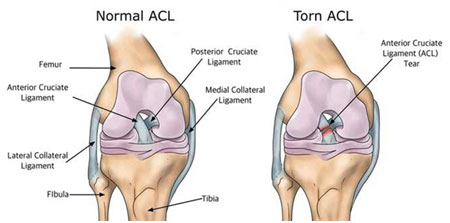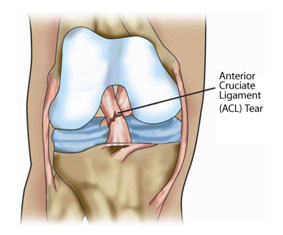ACL Injury
Ligaments are strong bands of tissue that connect one bone to another. The ACL, one of two ligaments that cross in the middle of knee, connects your thigh bone to your shinbone and help stabilize your knee joint.
ACL – one of the major ligaments in your knee. How can you know that it’s an ACL injury? So here we have mentioned ACL injury in depth which you can corelate with yours…
One of the most common knee injuries is an ACL sprain or tear
• Most common in athletes and sports player
• Most ACL injuries happen during sports and fitness activities that can put stress on the knee.
• Sudden slowing down and damaging direction
• Pivoting with your foot firmly planed
• Landing from a jump incorrectly
• Receiving a direct blow to the knee or collision, such as a football tackle.

Symptoms can be as below
• A loud “pop” or a “popping” sensation in the knee
• Severe pain and inability to continue activity
• Swelling that begins within a few hours
• Loss of range of motion
• A feeling of instability or “giving way” with weight bearing.
Surgeon decides his treatment as per severity of injury which is classified into Grades.
1. Grade 1: - when the ligament is stretched slightly but the stability of the knee joint is not affection.
2. Grade 2: - when the ligament is stretched to the point that it become loose, this is Also referred to as a partial tear.
3. Grade 3: - when the ligament is completely torn into two pieces, and the knee joint is no longer stable. This is the most common type of ACL injury.

Surgeon also perform few Clinical tests during consultation and can recommend you any of Diagnostic testing when and where it is needed
• X-ray: It will be recommended by doctor to rule out any bone injuries.
• MRI: An MRI can show the extent of ligament injury and sign of damage to other tissues in the knee.
• Ultrasound: Using sound waves to visualize internal structures, ultrasound may be used to check for injuries in the ligaments, tendons and mules of the knee.
Surgeon will decide the treatment based on his examination and investigations
• First- Aid care can reduce pain and swelling immediately after an injury to your knee. Rest, Ice, Compression, Elevation
• Physiotherapy is usually recommended in grade I and II sprains to treat non-surgically. It will help to improve strength and alignment in knees and kneecap, restore muscle strength, restore your range motion, provide pain relief
• Surgical treatment will be needed in case of severe or complete tear. Arthroscopic surgery: - It’s good to go for arthroscopy than open surgery, as it is a key hole surgery, with minimal cuts and stiches. It also promotes fast recovery post operatively. Physiotherapy will be strongly recommended post surgically for the best result.
Ligaments are strong bands of tissue that connect one bone to another. The ACL, one of two ligaments that cross in the middle of knee, connects your thigh bone to your shinbone and help stabilize your knee joint.
ACL – one of the major ligaments in your knee. How can you know that it’s an ACL injury? So here we have mentioned ACL injury in depth which you can corelate with yours…
One of the most common knee injuries is an ACL sprain or tear
• Most common in athletes and sports player
• Most ACL injuries happen during sports and fitness activities that can put stress on the knee.
• Sudden slowing down and damaging direction
• Pivoting with your foot firmly planed
• Landing from a jump incorrectly
• Receiving a direct blow to the knee or collision, such as a football tackle.




